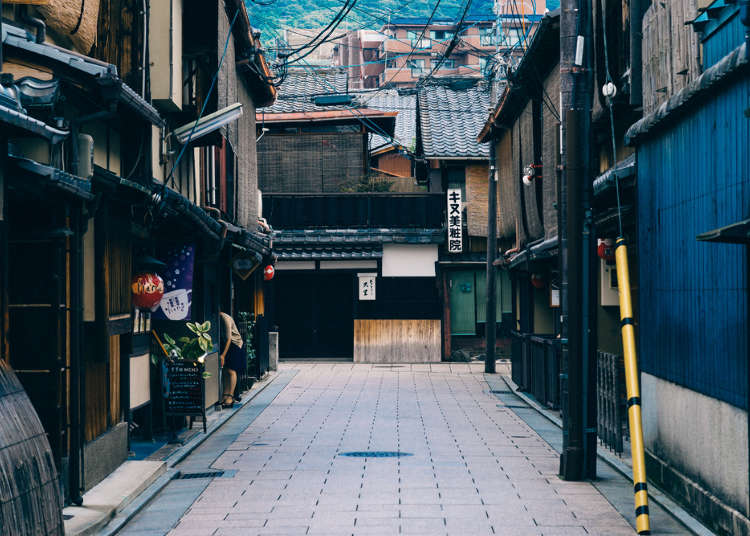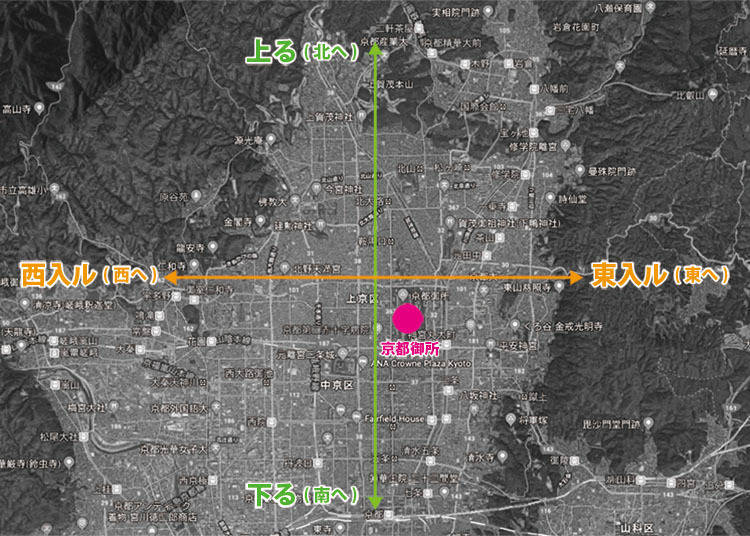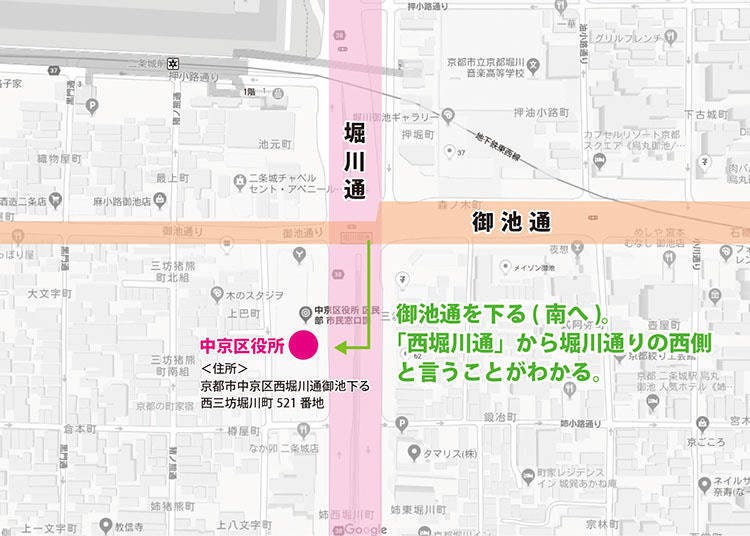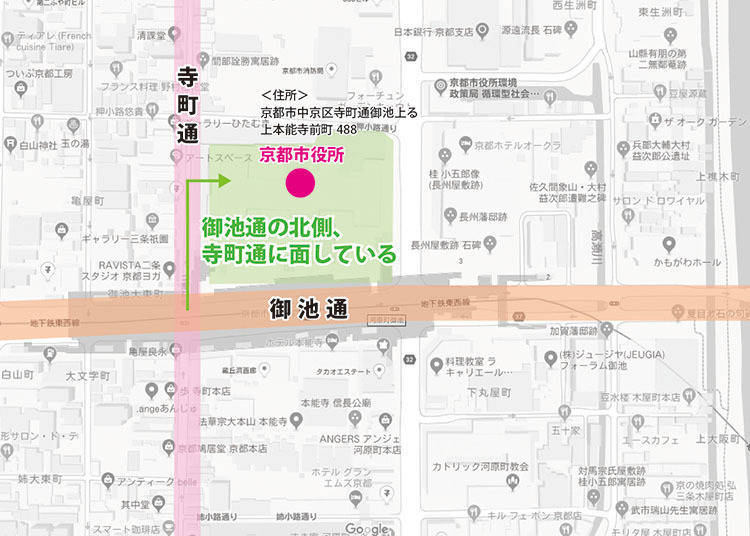
Kyoto is a storied city rich in historical shrines, temples, and cultural artifacts. Having spent more time as the nation’s capital than not, Kyoto’s unique culture remains deeply rooted. One example is its address system, which includes confusing words like “agaru,” “sagaru,” “higashi iru” and “nishi iru”. These are actually magical words that make it far easier to understand where things are and figuring out what they mean is sure to make your Kyoto trips that much easier. Let’s take a look at them.
- Table of Contents
main photo:Sean K / Shutterstock.com
Agaru, Sagaru, Higashi Iru, and Nishi Iru
Aside from city and town names, you’ll find mysterious words like agaru and sagaru, or higashi iru and nishi iru in Kyoto addresses. These pairs denote direction: north and south for agaru and sagaru, respectively, and east and west for higashi iru and nishi iru (“higashi” meaning “east”, and “nishi” meaning “west”). Still, the names of streets don’t always make it into Kyoto addresses. Those are mainly reserved for places near the city center: the wards of Kamigyo, Nakagyo, Shimogyo, and parts of Sakyo.
Handy to remember: Agaru is north, sagaru is south!

The main roads of Kyoto form the intersections of north and south, and east and west. This is called Jobose, “jo” referring to roads running north and south, “bo” referring to those running east and west, and “se” meaning “system”. When what is now modern Kyoto was built under the name Heian-kyo, the city adopted the structure of the Chinese capital at the time. The terms “agaru” and “sagaru” were used as on a Go board to make traffic around the intersection easier to understand. To go towards the imperial palace was to “agaru”, or go up, while to move away from it was to “sagaru”, or go down. However, moving further north of the imperial palace still falls under “agaru”, with the same holding true for going south of it with “sagaru.” There are many theories as to why this is so, from the term simply spreading after its inception, to the fact that Kyoto’s northern area is at a higher elevation. In any case, you’ll want to memorize them as “agaru” being going north and “sagaru” being going south.
“Higashi iru” and “nishi iru” refer to east and west. On a map with north pointing upwards, “higashi iru” will be to the right, and “nishi iru” will be to the left, pointing out whether one goes east or west of the great intersection.
Example: The “nishi iru” Kamigyo Ward Office

Take the Kamigyo Ward Office, for instance. Its address is 285 Horidashi-cho, Imadegawa Dori Muromachi Nishi iru, Kamigyo-ku, Kyoto. It has the name of the main road (Imadegawa Dori) and “Nishi iru” in it. Taking a closer look, we see that this means that this is to the west (left) of where roads Imadegawa and Muromachi intersect, as shown by the map above.
Example: The “sagaru” in the Nakagyo Ward Office

Let’s take a look at one with “sagaru” in the name. The Nakagyo Ward Office’s address is 521 Nishisanbo Horikawa-cho, Nishi Horikawa Dori Oike Sagaru, Nakagyo-ku, Kyoto. You “sagaru”, go down south, from the Oike Dori road. The “Nishi Horikawa Dori” denotes that it is on the west side of the road. (Said road used to go over a river, splitting it the area into east and west, with the ward office facing the west road.)
Example: The “agaru” in the Kyoto Municipal Office

The Kyoto Municipal Office’s address is 488 Kami Honnoji-mae, Teramachi Dori Oike Agaru, Nakagyo-ku, Kyoto. It’s north of Oike Dori road, as you can see on the map. You can also tell that it’s facing Teramachi Dori road from the address, as well.
There are some addresses that only have the street name, however. But, if you grasp the meaning of “agaru” and “sagaru” as well as “higashi iru” and “nishi iru,” you should be able to figure out where to go more easily. In fact, Kyoto denizens will often use the terms when explaining directions in Japanese.
Children’s songs for remembering road names
Still, remembering all of the names of the roads and their directions is a tough time. In ages past, people of Kyoto would memorize them with children’s songs. The pairs of north and south and east and west have their own songs. The east/west song, for example, starts with “maru take ebisu ni oshi oike,” using the first characters of the roads (starting from the northernmost road) Marutamachi, Takeyamachi, Ebisugawa, Nijo, Oshikoji, and Oike. The reason it starts with Marutamachi Dori is that the song came about during the Edo period, when there was nothing north of the road but farmland.

The people of Kyoto are still fond of their road names. Take the penguins of Kyoto Aquarium, named Nijo, Osshi, Oike, and more—names taken from the roads. Memorizing the song could help you remember where you are in Kyoto. Searching “Kyoto’s road song” should have it come up online. There’re also videos of the song on YouTube, so feel free to check those out. Understanding “agaru” and “sagaru” will really make you feel like you understand Kyoto a little better.
Text by:Niki Shigemi
*Prices and options mentioned are subject to change.
*Unless stated otherwise, all prices include tax.
Popular Tours & Activitiess
Recommended places for you
-

ISHIDAYA Hanare
Yakiniku
Kobe, Sannomiya, Kitano
-

Kambei Sannomiyahonten
Yakiniku
Kobe, Sannomiya, Kitano
-

Kiyomizu-dera Temple
Temples
Gion, Kawaramachi, Kiyomizu-dera Temple
-
Goods

Yoshida Gennojo-Roho Kyoto Buddhist Altars
Gift Shops
Nijo Castle, Kyoto Imperial Palace
-

Kanzenkoshitsuyakinikutabehodai Gyugyu Paradise Sannomiya
Yakiniku
Kobe, Sannomiya, Kitano
-

Jukuseiniku-to Namamottsuarera Nikubaru Italian Nikutaria Sannomiya
Izakaya
Kobe, Sannomiya, Kitano
-

Everything You Need to Know About teamLab Biovortex Kyoto (2025 Insider Guide)
by: Wemmy Chau
-

November Events in Kansai: Fun Festivals, Food, and Things to Do in Kyoto & Osaka
-

Best Things to Do and See Around Kyoto & Osaka in September: Events and Festivals in Kansai
-
Ad

Recharge and Relax with a Healing Getaway at Kamenoi Hotel Toba
-

History and Sustainable Brewing: World-Renowned Fukuju Sake at Kobe Shushinkan
by: WESTPLAN
-
Ad

Experiencing Manga as Culture, Not Just Reading It: Expo 2025 with Rumiko Takahashi
Inspiration for Accommodations
-

Spacious Family Hotel in Namba: 20 Comfortable Stays for Family Fun
-

Charming Hotels to Enjoy the Spectacular Views of Arashiyama's Autumn Leaves from Your Room
-

Experience Stunning Views of Osaka Castle from Private Spaces: Top Hotels Near Osaka Castle
-

Recommended by Visitors! Arashiyama's Best-Rated Hotels
-

Family-Friendly Universal Studios Japan Hotel with Excellent Access
-

Enjoy a Comfortable Stay in Osaka! 10 Hotels with Convenient Airport Shuttle Services
-

Top 10 Recommended Hotels Near Namba Station with Great Access
-

Enjoy Night Views from Your Room! Recommended Hotels in Namba Area
-

Kyoto Gion Walking Guide: Top 10 Must-See Areas for First-Time Visitors
-

5 Best Hotels Near Universal Studios Japan (Osaka): Top-Rated Places to Stay
by: WESTPLAN
-

Inside Kobe Tower: Fun Things to Do at the Symbol of Kobe
-

First Time in Nara: Where To Go And What To Do in Japan's Famous City
by: WESTPLAN
-

Inside Kyoto's Spectacular Sanjusangen-do Temple with 1,000 Gold Statues
-

Ninenzaka and Sannenzaka: Walking Guide to Kyoto's Best Old Streets
by: WESTPLAN
- #best gourmet Osaka
- #things to do Osaka
- #what to do in kyoto
- #what to bring to japan
- #best gourmet Kyoto
- #new years in Osaka
- #what to buy in nanba
- #Visiting Osaka
- #onsen tattoo friendly arima
- #daiso
- #Visiting Kyoto
- #best japanese soft drinks
- #japanese fashion culture
- #japanese convenience store snacks
- #japanese nail trends












